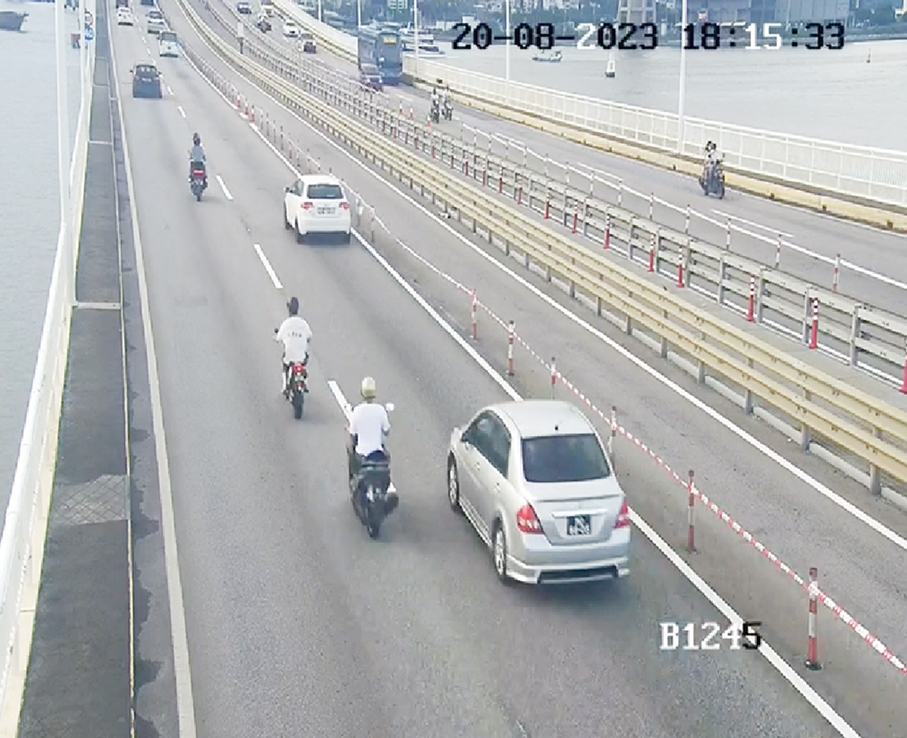The motorcycle-only lanes on the Macau-Taipa Sai Van Bridge have been temporarily closed for seven days since yesterday because of the government’s ongoing project of replacing worn expansion joints on the lanes with new ones.
The special motorcycle lanes are slated to reopen at 10 a.m. on Sunday, August 27.
During the ongoing seven-day temporary closure, which started at 10 a.m. yesterday, in each direction motorbike riders need to cross the bridge on the other two vehicular lanes, which normally motorcycles are banned from using.
The government announced the 168-hour temporary closure of Sai Van Bridge’s motorcycle lanes during a press conference on Friday. The press conference, which was held at the Transport Bureau (DSAT) Building on Estrada de D. Maria II, was hosted by Public Works Bureau (DSOP) official Wong Sio Leong, DSAT official Cheng Hoi Kin, and Public Security Police (PSP) senior officer Ho Ka Kit.
Sai Van Bridge, one of the three sea-crossing bridges connecting the Macau peninsula and Taipa, opened in January 2005.
Each direction of Sai Van Bridge has three vehicular lanes, one of which has been designated for motorcycles since August 2012.
Since then, motorcycles have been barred from using the other vehicular lanes on the bridge, except for the ongoing temporary closure of the motorbike lanes during which they have to use the other lanes.
The bridge’s special lanes for motorcycles have been set up to improve the safety of motorbike riders travelling between the peninsula and Taipa.
Sai Van Bridge’s motorcycle-only lanes started operating in August 2012 on a trial basis, after which the operation of the lanes became permanent in August 2016.
The bridge’s motorcycle-only lanes are on both sides of the central divider.
During Friday’s press conference, Wong noted that as Sai Van Bridge has been used for over 18 years, its expansion joints on the road surface have worn out to “various degrees”.
According to specialist websites, expansion joints on bridges allow the concrete to naturally expand and contract without cracking by absorbing thermal expansion and contraction (temperature-induced expansion and contraction of building materials) as well as allowing the bridges to accommodate its settlement, the shrinkage of its concrete, and the movement of vehicles.
Expansion joints are also known as movement joints.
Why closure for whole days?
Wong noted that the government had completed the replacement of worn expansion joints on Sai Van Bridge’s outer and left lanes in just one month, during which the lanes were closed to traffic at night only for the replacement of the expansion joints. When the outer and left lanes reopened to traffic in daytime, according to Wong, steel panels were placed on the areas of road surface affected by the expansion-joint-replacement project so that the lanes could reopen to traffic.
Wong said that after referencing the experience of replacing the expansion joints on the bridge’s outer and left lanes, the government had decided to close its motorcycle lanes for a number of days so that the replacement work can now be carried out at full pace, in which case the project’s duration can be significantly reduced to just one week. Wong underlined that this approach for replacing the motorcycle lanes’ expansion joints aims to minimise the impact on motorbike riders.
During the press conference, Cheng urged motorcycle riders to always use the bridge’s outer and left lanes as much as possible during the ongoing temporary closure of its motorcycle lanes. Cheng also noted that during the ongoing period when motorbike riders need to use the other lanes, they are also subject to a maximum speed limit of 80 kilometres per hour and a minimum speed of 40 kilometres per hour, the same as all other vehicles.
Sai Van Bridge’s motorcycle lanes have a maximum speed limit of 60 kilometres per hour, with no minimum speed limit.
Cheng insisted that during the ongoing temporary closure of the bridge’s motorcycle lanes, it was not practical to temporarily designate one of the other two lanes in each direction for motorcycles only, because of the bridge’s very busy vehicular traffic.
Moreover, Wong underlined that during the ongoing measure that is slated to end at 10 a.m. on August 27, it was not suitable to allow motorcycles to use the lower enclosed deck of Sai Van Bridge, because of the ongoing train operation tests carried out on the Light Rail Transit (LRT) Taipa-Barra section.
This photo taken from Taipa on Saturday shows Sai Van Bridge. – Photo: Tony Wong

This screenshot taken yesterday from the Transport Bureau’s (DSAT) citywide CCTV road-surveillance system, which the public can access on its website and allows drivers to check the real-time traffic situation of the city’s various locations, shows motorcycles travelling on Sai Van Bridge yesterday afternoon.








